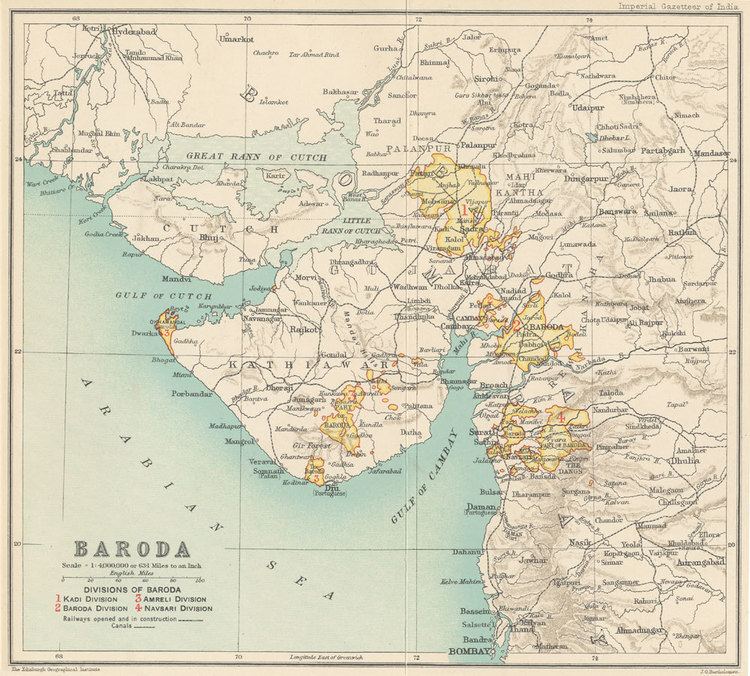1819–1922 → 1901 2,329,196 | Established 1819 | |
 | ||
1901 54,084 km (20,882 sq mi) | ||
The Kathiawar Agency, on the Kathiawar peninsula (Saurashtra lying between 20° 41′ and 23° 8′ N. and 68° 56′ and 72° 20′ E.; extreme length about 220 miles, greatest breadth about 165 miles, area about 23,445 square miles, and its 1001 population 2,645,805) in the western part of the Indian subcontinent, was a political unit of some 200 small princely states under the suzerainty of the Bombay Presidency of British India, now part of Gujarat state. About 1,245 square miles, with 173,436 persons, belonged to the Gaikwar; about 1,298 square miles, with 128,559 persons, to Ahmadabad District; about 20 square miles, with 14,614 persons, to the Portuguese possession of Diu; while the vast remainder (area 20,882 square miles and population 2,329,196) was the territory forming the Political Agency.
Contents
The agency's headquarters were at Rajkot, the town where the British Political Agent used to reside. He reported to the Political Department office at Bombay, Bombay Presidency.
History
The agency was formed in 1822, after the princely states in the area became British protectorates.
The region was severely affected by the famine of 1899–1900. Between 1891 and 1901 the population of the states covered by the Agency decreased by 15 per cent, largely due to the results of the famine.
On 10 October 1924 the agency was abolished and merged into the Western India States Agency, which had three subdivisions:
Princely States
According to the Imperial Gazetteer, the Kathiawar Agency was divided for administrative purposes into four prants or divisions - JHALAWAR, HALAR, SORATH and GOHELWAR - and its 193 princely states had since 1863 been arranged in seven classes: eight First-class States, six Second-class states, eight Third-class states, nine Fourth-class states, sixteen Fifth-class states, thirty sixth-class states, five seventh-class states, with the remaining 111 petty states combined into thana circles.
There were altogether 193 states of varying size and importance, of which fourteen exercised independent jurisdiction, while the rest were to varying degrees under British administration. The eight states of the first class were Bhavnagar State, Dhrangadhra State, Gondal State, Jafarabad State, Junagadh State, Morvi State, Nawanagar State and Porbandar State. The agency covered an area of 20,882 square miles (54,080 km2), and in 1901 the population was 2,329,196. The headquarters of the political agent (who oversaw the affairs of the princely states on behalf of the Governor-General) was at Rajkot, in the centre of the peninsula; this was also the site of the Rajkumar College, Rajkot, where many of the sons of the rulers were educated. There was a similar school for girasias, or chiefs of lower rank, at Gondal.
The estimated gross revenue of the several states was 1,278,000 rupees in 1911; total tribute (payable to the British, the Maharaja Gaekwar of Baroda and the Nawab of Junagadh), was 70,000 rupees.
An excellent system of metre-gauge railways was built at the cost of the leading states. Maritime trade was also very active, the chief ports being Porbandar, Mangrol and Veraval. In 1903–1904 the total seaborne exports were valued at 1,300,000 rupees, and the imports at 1,120,000.
